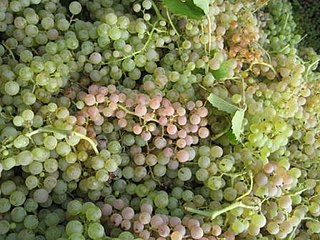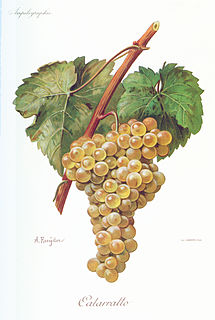Related Research Articles

Garganega is a variety of white Italian wine grape widely grown in the Veneto region of North East Italy, particularly in the provinces of Verona and Vicenza. It is Italy's 6th most widely planted white grape. It forms the basis of Venetian white wine Soave and is also a major portion of the blend used to make Gambellara.

Verdicchio is a white Italian wine grape variety grown primarily in the Marche region of central Italy. The name Verdicchio derives from verde and refers to the slight green/yellow hue that wines made from the grape can have.

Vermentino is a light-skinned wine grape variety, primarily found in Italian wine. It is widely planted in both in Sardinia and Liguria, to some extent in Corsica, in Piedmont under the name Favorita, and in increasing amounts in Languedoc-Roussillon. The leaves are dark green and pentagonal. The grapes are amber-yellow and hang in pyramidal bunches. The vines are often grown on slopes facing the sea where they can benefit from the additional reflected light. The Vitis International Variety Catalogue now gives Italy as its origin.
Greco is an Italian wine grape that may be of Greek origin. The name relates to both white (Greco bianco) and black (Greco nero) grape varieties. While there is more land area dedicated to Greco nero, the Greco bianco is the grape most commonly referred to by "Greco". In the Campania region it is used to produce the Denominazione di Origine Controllata e Garantita (DOCG) wine Greco di Tufo. In Calabria, it is used to make the Denominazione di Origine Controllata (DOC) wine Greco di Bianco. The name "Greco" is sometimes used as a synonym for several varieties of supposed Greek origins-most notably Trebbiano.

Fiano is a white Italian wine grape variety that is grown primarily in the Campania region of southern Italy and on the island of Sicily. In Campania, this fairly strong flavored white wine grape is particularly noted around Avellino where the Denominazione di origine controllata e Garantita (DOCG) wine of Fiano di Avellino is produced. The grape has a long history in the Campanian region and is believed to have been the grape behind the ancient Roman wine Apianum. Even today, the name Apianum is permitted to appear on wine labels of the DOCG wine Fiano di Avellino.
Verdeca is a white Italian wine grape variety that is primarily grown in the Colli Piacentini region of Emilia-Romagna in central Italy and Apulia in southern Italy where ampelographers believe that the grape may have originated. In Apulia, it is one of the main grapes in the Denominazione di origine controllata wines of Locorotondo DOC and Martina Franca DOC along with Bianco d'Alessano. In Campania, it is grown on the slopes of Mount Vesuvius where it used as a blending variety with Falanghina, Coda di volpe and Greco in both the white wines and the sweet dessert wine of the region, Lacryma Christi. It is also a minor component used in the some vermouth production.

Calabrian wine is Italian wine from the Calabria region of southern Italy. Over 90% of the region's wine production is red wine, with a large portion made from the Gaglioppo grape. Calabria has 12 Denominazione di origine controllata (DOC) regions, but only 4% of the yearly production is classified as DOC wine. The region is one of Italy's most rural and least industrialized with per capita income less than half of the national average. Following World War II, many of Calabria's inhabitants emigrated to Northern Italy, the United States, Australia and Argentina. Those left behind have been slow to develop a vibrant wine industry with only the red wines of Cirò garnering much international attention. Today Calabrian wines are mostly produced to high alcohol levels and sold to co-operatives who transfer the wines to the northern Italian wine regions to use as blending component. There are no Denominazione di Origine Controllata e Garantita (DOCG) regions, but Calabria does have 12 Indicazione Geografica Tipica (IGT) designations.

Grechetto or Grechetto bianco is a white Italian wine grape variety of Greek origins. The grape is planted throughout central Italy, particularly in the Umbria region where it is used in the Denominazione di origine controllata (DOC) wine Orvieto and Denominazione di origine controllata (DOC) wine Valdichiana Toscana. It is primarily a blending grape, though some varietal wine is also produced. Grechetto is commonly blended with Chardonnay, Malvasia, Trebbiano and Verdello. The grape's thick skin provides good resistance to downy mildew which can attack the grape late in the harvest season. This makes Grechetto a suitable blending grape in the production of Vin Santo.
Bombino bianco is a white Italian wine grape variety planted primarily along Italy's Adriatic coast line, most notably in Apulia. The vine is prone to high yields and often produces neutral flavor wines. The grape is known under many synonyms throughout Italy including Debit and Pagadebit, names which came from the grape's reputation for being a high yielding and reliable crop for vineyard owners to grow that would assure them that on each vintage they could pay off their debts.

Catarratto is a white Italian wine grape planted primarily in Sicily where it is the most widely planted grape. Overproduction of Catarratto was a substantial contributor to the perceived European wine lake problem in the mid 2000s. Catarratto can make full bodied wines with lemon notes. In the Etna DOC, the grape is often blended with Minella bianca and Carricante.

Incrocio Manzoni or Manzoni grapes is a family of grape varieties named after Professor Luigi Manzoni (1888-1968) of Italy's oldest school of oenology located in Conegliano, in the Veneto region. Manzoni created the new grape varieties by selecting, crossing and grafting vines from various vineyards during the 1920s and 1930s. The family includes both white and red grape varieties. Although most Manzonis are grown in northeastern Italy, they are mainly grown in the Piave area of Province of Treviso and are only now starting to be sold commercially in Europe and the United States.

Albarola is a white Italian wine grape variety grown in the northwest Italy. It is most commonly found in the Liguria region where producers in the Cinqueterre Denominazione di origine controllata (DOC) use it as a blending component. Wine expert Jancis Robinson describes the wine made from Albarola as fairly "neutral" in profile. Outside of Liguria, the grape was historically grown in Sicily but for most of the 20th century has been declining in plantings along with other ancient Sicilian varieties like Albanello, Damaschino, Minella bianca and Montonico bianco.

Coda di Volpe is a white Italian wine grape variety that has been historically grown in the Campania region around the town of Naples. It is often confused with another white Italian wine grape, Emilia, that share many of the same synonyms as Coda di Volpe.
Mantonico bianco is a white Italian wine grape variety that is grown in the Calabria region of southern Italy. Ampelographers believe that the grape is likely of Greek origins and was transported to southern Italy by ancient Greek settlers. Though the variety has a long history in Calabria, its numbers have been slowly declining with 1100 hectares/2700 acres planted in the region by the end of the 20th century.
Albaranzeuli bianco is a white Italian wine grape variety that is grown primarily in Sardinia. Ampelographers use to believe that the grape was originally Spanish in origin and was introduced to the island when it was ruled by the Crown of Aragon. Recent DNA profiling has suggested that the grape may have originated on the island as a crossing between the red Sardinian wine grape Girò and the Spanish table grape Molinera, known locally as Pansa Rosa di Málaga and distinct from the Veneto wine grape Molinara that is used in Amarone. A pink skinned grape known as Albaranzeuli nero is also found in Sardinia but its exact relationship to Albaranzeuli bianco is not yet clear.
Retagliado bianco is a white Italian wine grape variety that has been growing in Sardinia since at least the late 19th century. Here it is an authorized grape in the Indicazione geografica tipica (IGT) wines of Colli del Limbara where it is usually blended with Vermentino.
Besgano bianco is a white Italian wine grape variety that was historically used in the production of the dessert wine Vin Santo, blended with Malvasia Bianca Lunga and Verdea, but today is rarely planted and is more often used for table grape production than winemaking. The grape is also known as Colombana bianca but it is not a color mutation of the Tuscan and Emilia-Romagna wine grape Colombana nera.
Mantonico bianco is a white Italian wine grape variety grown in the Calabria wine region of southern Italy. The grape should not be confused with the similarly named Calabrian grape Montonico bianco or with Guardavalle, which is known as Mantonico in the province of Cosenza in Calabria. In the early 21st century, DNA profiling suggested that Mantonico bianco may be one of the parent varieties of the red Calabrian grape Gaglioppo which is also known as Mantonico nero.
Pallagrello bianco is a white Italian wine grape variety that is grown in Campania. The grape has a long history in the region and was one the varieties planted in 1775 by architect and engineer Luigi Vanvitelli in the fan-shaped Vigna del Ventaglio vineyard created for the royal palace of King Ferdinand I of the Two Sicilies in Caserta. Following the phylloxera epidemic of the mid-19th century and the economic devastation of the World Wars of the early 20th century, plantings of Pallagrello bianco declined greatly and the variety was thought to be extinct until it was rediscovered growing in an abandoned Campanian vineyard in the 1990s.
Bianco d'Alessano is a white Italian wine grape variety that is grown in the Apulia region of southern Italy, where it is often blended with Verdeca. In the early 21st century, the grape was planted in the South Australian wine region of Riverland where varietal examples of Bianco d'Alessano has won wine competition awards as an "Alternative Variety". In Italy, the grape has also been historically used in the production of vermouth.
References
- ↑ J. Robinson Jancis Robinson's Guide to Wine Grapes pg 33 Oxford University Press 1996 ISBN 0-19-860098-4
- ↑ Grape Varieties Bosco (Italian) La Vignaioli Piemontesi Accessed: December 6th, 2010